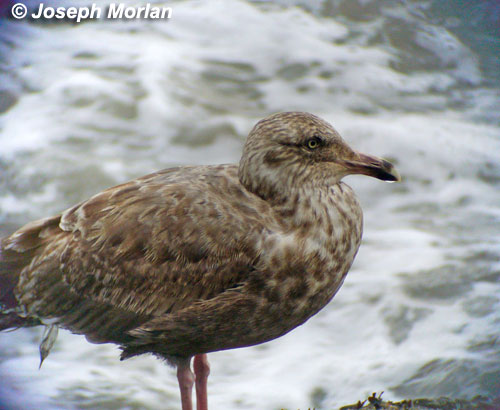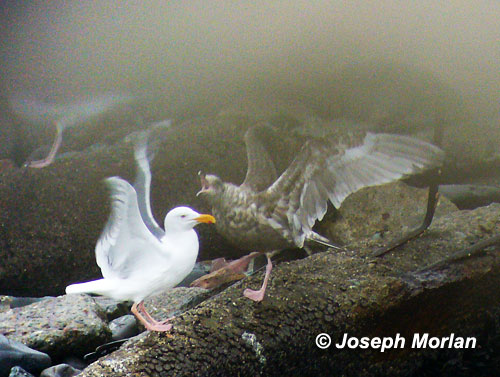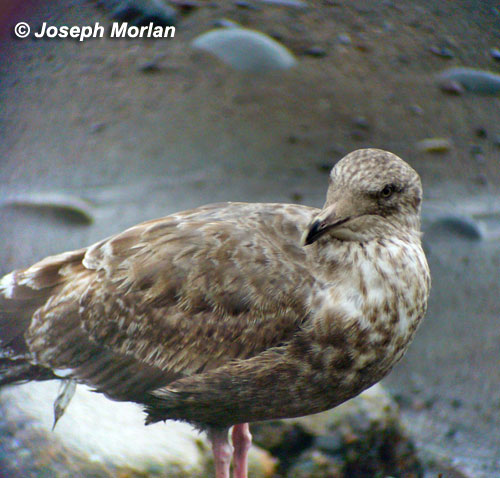Slaty-backed Gull (Larus schistisagus)
Fort Baker, San Francisco County CA
7 February 2012
Joseph Morlan
Photos © 7 February 2012 by Joseph Morlan. All rights reserved (High resolution).
 After hearing reports that Todd Easterla had found two Slaty-backed Gulls
at Fort Baker in the Marin Headlands, Robbie Fischer and I decided to try for these birds as well as the continuing
Iceland Gull. Upon arriving around 4:00pm, we learned that the adult Slaty-backed had flown off sometime earlier.
While we searched the mudflats looking for the Iceland Gull, Robbie noticed John Luther signaling from the Coast
Guard pier. We headed over to where Todd was pointing excitedly towards an interesting gull that he thought was
an immature Slaty-backed. The bird landed on the rocky shore between the jetty and the Golden Gate Bridge. We studied
the bird through scopes and then followed Todd over to the rocky shore where we were afforded very close views.
Here I attempted to digiscope the bird which was too close to get the entire bird into my field of view. Other
people including Dan Singer took much better photos including photos in flight. There was considerable discussion
about the identification, with the consensus being that it was a second cycle Slaty-backed. However, this is not
a plumage with which I am fami
After hearing reports that Todd Easterla had found two Slaty-backed Gulls
at Fort Baker in the Marin Headlands, Robbie Fischer and I decided to try for these birds as well as the continuing
Iceland Gull. Upon arriving around 4:00pm, we learned that the adult Slaty-backed had flown off sometime earlier.
While we searched the mudflats looking for the Iceland Gull, Robbie noticed John Luther signaling from the Coast
Guard pier. We headed over to where Todd was pointing excitedly towards an interesting gull that he thought was
an immature Slaty-backed. The bird landed on the rocky shore between the jetty and the Golden Gate Bridge. We studied
the bird through scopes and then followed Todd over to the rocky shore where we were afforded very close views.
Here I attempted to digiscope the bird which was too close to get the entire bird into my field of view. Other
people including Dan Singer took much better photos including photos in flight. There was considerable discussion
about the identification, with the consensus being that it was a second cycle Slaty-backed. However, this is not
a plumage with which I am fami liar.
liar.
Description
The following description is based on memory and on photos:
A large gull, about the size of a Western Gull.
The bird was mostly brown with a mottled head and chest and a dark area around the light eye. A postocular
line extended behind the eye. The mantle contained a mixture of old brown feathers and some new dark gray ones.
The bill was narrow, not swollen like most Western Gulls with dull pink at the base and gray band near the tip.
The hook was ivory colored. The rump was white with the base of the tail barred laterally. Otherwise the tail was
dark brown. The legs and feet were pink.
The underside of the wings were pale with dusky tips to the outer five primaries. One of the primaries seemed
to show a white tongue extending down the outer web suggesting the beginning of a "string of pearls pattern."
Overall I thought the underwing pattern was similar to that of immature Thayer's Gull. I have added a distant photo
above right showing the underwing pattern. I believe Dan Singer has much better images.
Discussion
 This
bird does not seem to resemble any of the photos on the "Gulls of the Americas" book by Howell and Dunn.
I origianlly thought the bird was first cycle because of its overall brown coloration with only a few gray mantle
feathers. I assumed that a second cycle bird would have a whiter body, more extensive gray mantle and an obvious
patch of pale on the wing coverts by February. However Dan Singer and Todd Easterla concluded it was actually a
second cycle because of the truncate, less pointed shape to the primary tips and because of the light eye coloration.
I suspect that their analysis is correct.
This
bird does not seem to resemble any of the photos on the "Gulls of the Americas" book by Howell and Dunn.
I origianlly thought the bird was first cycle because of its overall brown coloration with only a few gray mantle
feathers. I assumed that a second cycle bird would have a whiter body, more extensive gray mantle and an obvious
patch of pale on the wing coverts by February. However Dan Singer and Todd Easterla concluded it was actually a
second cycle because of the truncate, less pointed shape to the primary tips and because of the light eye coloration.
I suspect that their analysis is correct.
The mottled and streaked pattern on the head and chest look quite different from Western Gull, but I am not
sure of the significance of this. After considerable conversation I agree that this bird is likely a Slaty-backed
Gull, although I'm not sure if it might be some hybrid combination involving Herring Gull or maybe an just an odd
Herring Gull with unusual molt. However the darkness of the incoming mantle feathers argues against pure Herring
Gull. Nevertheless, to be honest I never would have picked this bird out as a Slaty-backed Gull if I were birding
on my own.
This location straddles the county line between Marin and San Francisco counties. Apparently San Francisco claims
the water at mean high tide and the land is in Marin County. If so, this bird was seen in both counties.
Addendum (3 April 2013)
The California Bird Records Committee did not accept this record. The vote was 5-4 in favor on the first round
and 3-6 against on the second circulation. I was not a committee member at the time of these votes, but given
the vaguaries of this individual, the committee made a decision which I support.
 After hearing reports that Todd Easterla had found two Slaty-backed Gulls
at Fort Baker in the Marin Headlands, Robbie Fischer and I decided to try for these birds as well as the continuing
Iceland Gull. Upon arriving around 4:00pm, we learned that the adult Slaty-backed had flown off sometime earlier.
While we searched the mudflats looking for the Iceland Gull, Robbie noticed John Luther signaling from the Coast
Guard pier. We headed over to where Todd was pointing excitedly towards an interesting gull that he thought was
an immature Slaty-backed. The bird landed on the rocky shore between the jetty and the Golden Gate Bridge. We studied
the bird through scopes and then followed Todd over to the rocky shore where we were afforded very close views.
Here I attempted to digiscope the bird which was too close to get the entire bird into my field of view. Other
people including Dan Singer took much better photos including photos in flight. There was considerable discussion
about the identification, with the consensus being that it was a second cycle Slaty-backed. However, this is not
a plumage with which I am fami
After hearing reports that Todd Easterla had found two Slaty-backed Gulls
at Fort Baker in the Marin Headlands, Robbie Fischer and I decided to try for these birds as well as the continuing
Iceland Gull. Upon arriving around 4:00pm, we learned that the adult Slaty-backed had flown off sometime earlier.
While we searched the mudflats looking for the Iceland Gull, Robbie noticed John Luther signaling from the Coast
Guard pier. We headed over to where Todd was pointing excitedly towards an interesting gull that he thought was
an immature Slaty-backed. The bird landed on the rocky shore between the jetty and the Golden Gate Bridge. We studied
the bird through scopes and then followed Todd over to the rocky shore where we were afforded very close views.
Here I attempted to digiscope the bird which was too close to get the entire bird into my field of view. Other
people including Dan Singer took much better photos including photos in flight. There was considerable discussion
about the identification, with the consensus being that it was a second cycle Slaty-backed. However, this is not
a plumage with which I am fami liar.
liar. This
bird does not seem to resemble any of the photos on the "Gulls of the Americas" book by Howell and Dunn.
I origianlly thought the bird was first cycle because of its overall brown coloration with only a few gray mantle
feathers. I assumed that a second cycle bird would have a whiter body, more extensive gray mantle and an obvious
patch of pale on the wing coverts by February. However Dan Singer and Todd Easterla concluded it was actually a
second cycle because of the truncate, less pointed shape to the primary tips and because of the light eye coloration.
I suspect that their analysis is correct.
This
bird does not seem to resemble any of the photos on the "Gulls of the Americas" book by Howell and Dunn.
I origianlly thought the bird was first cycle because of its overall brown coloration with only a few gray mantle
feathers. I assumed that a second cycle bird would have a whiter body, more extensive gray mantle and an obvious
patch of pale on the wing coverts by February. However Dan Singer and Todd Easterla concluded it was actually a
second cycle because of the truncate, less pointed shape to the primary tips and because of the light eye coloration.
I suspect that their analysis is correct.